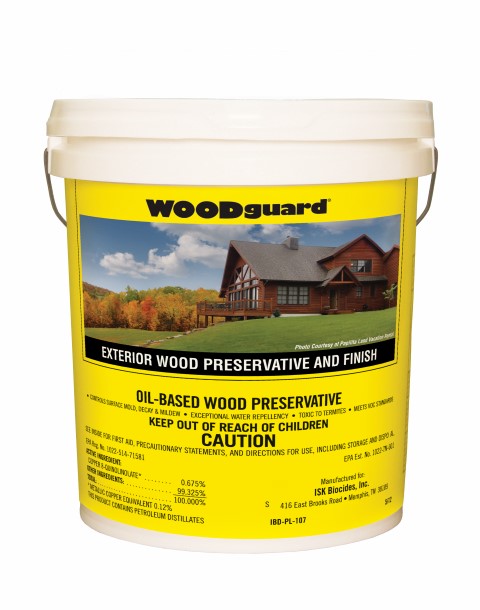WOODguard®
Exterior Wood Preservative and Finish
Semi-transparent stain and EPA-registered wood preservative all in one product.
Preserve the appeal of your wood’s natural appearance with WOODguard®, our highly durable wood preservative stain backed by over 30 years of proven performance. By penetrating deeply into the wood on log homes and log siding, this oil-based formula provides exceptional water repellency and protection against termites and damaging UV rays. In fact, with an easy one-coat application, WOODguard works to vigorously protect your wood without forming a film that will crack or peel.
Questions & Answers
WHAT IS WOODGUARD?
WOODguard is a one coat, oil based EPA registered wood preservative, designed for exterior log homes and siding. This coating is available in five tints and contains titanium dioxide which reduces damage from the sun’s ultraviolet rays.
WHERE CAN I FIND WOODGUARD?
To find the nearest distributor, click on the Dealer Locator button on the home page or contact ISK Biocides.
HOW MUCH WILL I NEED?
On initial applications one gallon of WOODguard will cover approximately 150 square feet of re-sawn cedar siding or about 200 square feet of logs. To use a rough calculation, multiply the length times the height of the home times 1.4 (Area = Length X Height X 1.4). The 0.4 takes into account windows and doors. Always apply as much WOODguard as can be absorbed by the wood. Only one coat is required. However, that one coat must be applied to the point of refusal.
IS WOODGUARD EASY TO USE?
WOODguard is easy to apply via brush, coarse spray or roller. A garden pump-up sprayer is recommended and back brushed to an even coat. Just apply to the point of refusal. WOODguard does its job with just one initial coat. WOODguard cleans up easily with mineral spirits. Do not apply with an airless sprayer.
WHEN IS A GOOD TIME TO APPLY WOODGUARD?
The best time to apply WOODguard is when the minimum night-time temperature is 50°F or higher and daytime high temperature is 95°F or lower. Do not apply during or right after a rain. The wood surface must be dry before you initiate application.
IS WOODGUARD VOC COMPLIANT?
WOODguard is VOC compliant and meets all current state and federal air quality requirements. The active ingredient, copper 8 quinolinolate is suitable for use on wood that may have incidental food contact.
WHAT ARE THE BENEFITS OF USING WOODGUARD?
WOODguard protects against cupping, curling and warping. WOODguard controls fungus, wood decay, mold, mildew, termites and anabiid beetles with its EPA registered wood preservative Copper-8-Quinolinolate. WOODguard penetrates deep and cures below the wood surface to enhance the natural beauty of wood. WOODguard contains several transparent UV blocking pigments which help protect the finish from the sun’s damaging UV (ultra violet) rays and preserves the natural beauty of the log finish for years.
HOW DOES WOODGUARD WORK?
WOODguard’s oil formula penetrates deeply into the wood structure, coating the wood cells where it molecularly bonds into the wood. WOODguard cures in a liquid state and remains flexible. WOODguard will not harden or crack through wide temperature and moisture extremes.
HOW IS WOODGUARD RATED?
An independent study of the log home industry concluded that WOODguard is the exterior wood preservative and stain most recommended to consumers by builder/dealers nationwide. The survey also revealed that more log home models were treated with WOODguard than any other product during their previous application.
WHAT TYPE OF CAULK SHOULD I USE WITH WOODGUARD?
An oil based caulk is usually best, especially when applied over newly cured WOODguard. Consult your WOODguard dealer for specific brand recommendations.
WHAT IS WRONG?
My house has 3,000 square feet of exterior surface area to treat. My contractor applied 7 gallons of WOODguard. Three months later it looks like it’s gone. Way too little WOODguard was applied. Always apply WOODguard to the point of refusal. If you can’t get new wood to accept at least a gallon of product for each 175 square foot area, suspect a mill glaze problem.
WHAT IS MILL GLAZE?
Mill glaze is a resinous surface barrier that is created in the log sawing and milling process. It must be removed prior to application of WOODguard to allow maximum penetration of WOODguard. This can be accomplished by washing the wood with a dilution of Tri-Sodium Phosphate (TSP) in a gallon of water and a pressure spray water rinse.
CAN YOU USE WOODGUARD ON DECKS?
We recommend WOODguard SWO for this use. Click here for more information WOODguard SWO.
THE WOODGUARD ON MY HOUSE WENT ON VERY DARK. IT IS WAY DARKER THAN THE COLOR SHOWN IN PICTURES AND ON THE WEBSITE. WHAT’S WRONG?
Nothing is wrong! WOODguard goes on VERY dark and lightens considerably during the cure period. If your WOODguard is NOT DARK upon initial application, this is an indication that you are not applying it to the point of refusal and are not getting a proper treatment.
WHEN SHOULD I ADD ADDITIONAL MILDEWCIDE TO MY WOODGUARD? WHAT KIND IS RECOMMENDED?
If the exposure conditions are going to be very hot and humid or otherwise adverse, additional mildewcide can be added to provide extended mildew control. WOODguard cannot prevent the reoccurrence of mold and mildew on extremely dirty surfaces or inadequately ventilated areas. If you decide to add mildewcide, we recommend M-1® which contains 3-lodo-2 propynlbutyl carbamate, better known as IPBC. Consult your WOODguard dealer for assistance.

